Hessian Soldiers
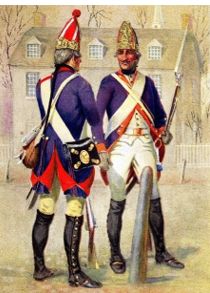 18
18Aug
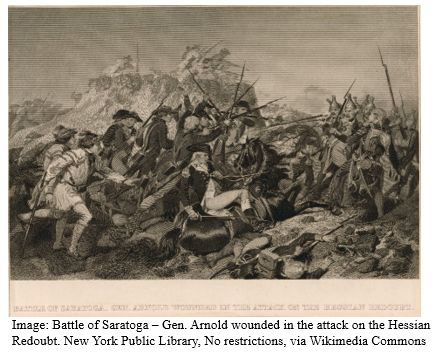
People have come to America for a variety of reasons. During the years of the American Revolutionary War (1775-1783), about 30,000 Hessian Soldiers arrived in North America from Germany. At the end of the war, around 6,000 soldiers remained in North America and settled in Canada and the United States. This blog will provide a brief history of the Hessian Soldiers and discuss available resources in researching them.
Brief history and overview
At the commencement of the American Revolutionary War (1775-1783), King George III of Great Britain needed additional troops to increase his fighting power. Former allies were contacted for help, and, following a common practice at the time, auxiliary troops from foreign countries were hired. The following six principalities within the Holy Roman Empire of the German Nation signed treaties with Great Britain to provide troops for the war.
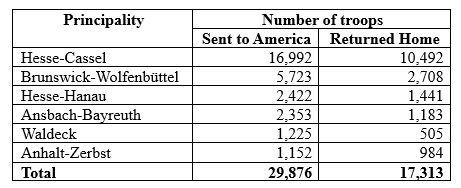
These hired troops have often been incorrectly referred to as mercenaries. The term mercenaries refers to individuals who are not members of a military unit and who participate in a conflict for personal gain. The troops contracted by Great Britain were auxiliary troops. The term auxiliary troops refers to units of soldiers hired out by their government. They served side by side with foreign armies while maintaining their usual unit structure, officers and wearing their own uniforms. It should be noted that Hessian soldiers were not the only Germans who fought in the Revolutionary War. Some Germans were recruited to serve in the British infantry regiments, wearing British uniforms. Others were recruited by France and served in the French Royal Deux-Ponts infantry. Germans who had immigrated to America prior to the war also participated.
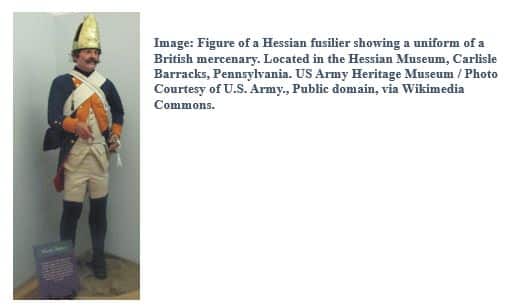
Over the course of the war, about 30,000 Hessian troops, representing about a third of the British forces, came to North America. More than half of these came from Hesse-Cassel, which led to all auxiliary troops hired by Great Britain being referred to as Hessians, regardless of their true state of origin. It is also interesting to note that not all members of the auxiliary troops were natives of the associated six states. For example, birth places of soldiers from Brunswick included Hesse-Homburg, Bavaria, Moravia, Saxony, Lithuania, The Netherlands, Poland, and Berlin.
It is estimated that of the roughly 30,000 Hessian soldiers who came to America, about 6,000 either deserted or were discharged and remained in the United States and Canada after the war. About 2,500 settled in Canada, the majority in Quebec and some also in New Brunswick, Nova Scotia, Prince Edward Island, and present-day Ontario. In the United States, they settled anywhere from the Canadian border south to Florida. Many settled in German-speaking areas in Pennsylvania, New York, New Jersey, Virginia, and the Carolinas. Understanding where the various regiments served may provide clues about an ancestor’s place of origin. The following table provides a list of the general locations where troops from the different German principalities served. Soldiers who did not return home usually stayed in the general area of where they last served or departed from the army.
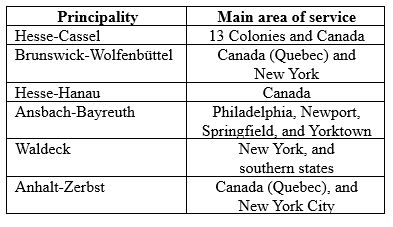
Resources
A number of resources are available in your search for and about Hessian soldiers. Following are only a few. Additional resources can be found in the FamilySearch wiki article “Hessian Soldiers.” (https://www.familysearch.org/en/wiki/Hessian_Soldiers)
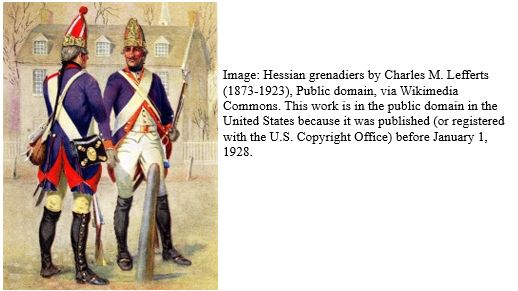
- HETRINA (Hessische Truppen in Amerika / Hessian Troops in America) (https://www.lagis-hessen.de/en/subjects/xsform/sn/hetrina)
This database includes soldiers who served in regiments from Hesse-Cassel, Hesse-Hanau and Waldeck. Some of the information provided includes the soldier’s name, town, approximate year of birth, rank, regiment, and date/type of event. Original sources for this database are held at the Hessian State Archive in Marburg. Using the Extended Search option provides a variety of search fields. HETRINA also includes links to a timeline of military events 1775-1783, and a Discover section with information on the history, force level, commanders, uniforms, etc. about the individual regiments.
- Johannes Schwalm Historical Association (JSHA) (https://www.jsha.org/)
The association’s purpose is to research the German auxiliary troops who remained in America after the Revolutionary War. One of the pages on the JSHA website is the JSHA Registry page which includes links to four different lists of German Auxiliary soldiers: 1) registry of researched soldiers, 2) registry of partially researched soldiers, 3) list of men in the very early stage of study, and 4) names of men who have been positively identified as Hessian ancestors by researchers. The registry of researched soldiers lists soldiers alphabetically by surname, with some associated information, which can include the German principality, town of origin, military rank or rating, military unit, source of the military record, personal information, wife’s name, settlement location, and reference to sources of additional information, if applicable. Several entries reference a published profile for the individual in the JSHA’s Journal, The Hessians.
The association also has a large collection of primary sources which is housed at Kutztown University. The Johannes Schwalm Historical Association, Military and Naval Microfilm Archive Collections include a variety of items, e.g., digitized regiment information and lists, diaries, letters, watercolors, monthly reports, books about Hessian units’ uniforms, finding aids, and various American, British, and German manuscript collections.
You can access the Schwalm collection here: https://research.library.kutztown.edu/schwalm/
- AMREV-HESSIAN Mailing List Website https://freepages.rootsweb.com/~amrevhessians/military/o/ourhessians.htm (click on Site Menu to skip to bottom of page for list of links)
The AmRev-Hessian website provides links to resources related to Hessian soldiers, such as historical background, name lists, extracts of historical documents, prison camps, transport ships, journals and diaries, parish registers, etc.
One of the resources available through this website is the PDF (Personal Data Files) On Hessians webpage (https://freepages.rootsweb.com/~amrevhessians/military/pdf-index.htm), which includes write-ups on forty-six soldiers who stayed in Canada, and sixty-six who stayed in the United States. This information was compiled by Johannes (or John) Helmut Merz. Mr. Merz, a retired researcher and historian, researched Hessian soldiers extensively and shared his findings in numerous publications.
By Gina
(Portions of this writing were published earlier as the FamilySearch webinar about Hessian Soldiers presented by the author, https://www.familysearch.org/en/help/helpcenter/lessons/hessian-soldiers-introduction, and in Germanic Genealogy Journal 25:1-2 (Spring-Summer 2022):24-30.)
